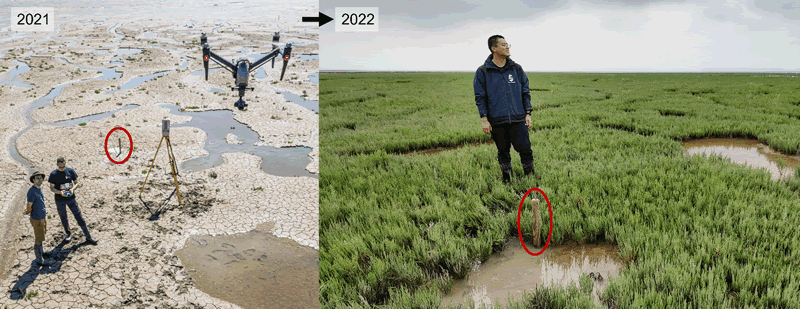G.S. Fivash1*, J. van Dalen1, J. van Belzen1, M. Stoorvogel1, J.C. de Smit1, F. van Rees2,3, C. Mc Leod3, S. Temmerman4, T.J. Bouma1,2
1 NIOZ; 2 Utrecht University; 3 Deltares; 4 University of Antwerp
*corresponding author:
Introduction
Predicting where intertidal vegetation will occur in the future is important for the management of nature in our estuaries. Currently we rely mainly on measurements of elevation and local hydrodynamic forces to predict the occurrence of vegetation. However, small-scale morphological features on the tidal flat known as 'ridge-runnel patterns' have been found to create uniquely suitable habitat for the establishment of pioneer vegetation. If these patterns are to play an important role in the transition between tidal flats and marshes, it is important that we understand (1) how and why they form, and (2) where we are most likely to find them.

Figure 1: Photos of the same tidal flat near the marsh of Zuidgors in the Western Scheldt, NL, in 2021 and 2022, where ~20 ha of marsh expansion occurred in a single year. Note the pattern of ridges and pools on the tidal flat in 2021. The red ovals highlight a reference pole featured in both photos.
Methods
We investigated these questions using a combination of geospatial surveys, field measurements, and laboratory flume experiments.
Results
We found that ridge-runnel patterns generally form in very silty sediment, high in the tidal frame (above neap high water), on tidal flats of very shallow slope (< 3 degrees). The ridges of the patterns are protected by no more than a 2 mm thick layer highly cohesive erosion-resistant sediment that does not form beneath pooling water. This layer forms on extremely short time scales and can form significant erodibility gradients across the landscape within 24 hours, as long as the sediment remains undisturbed. We think that the build-up of this erosion-resistant dry layer is the key mechanism driving pattern formation, and later facilitating seedling establishment. In this regard, ridge-runnel patterns could be considered a transitional stage between a tidal flat and a marsh. Thus, when the patterns become a consistent feature of a tidal flat, it strongly indicates future marsh expansion into area. By monitoring the formation, longevity, and growing intensity of these patterns with aerial photography, we can receive prior warning of vegetation expansion potentially years in advance of the actual appearance of new vegetation.
I. Surname1*, F.N. Another-Surname2 , Y. Next-Surname2
1 University Name, Country; 2 Organization Name, Country
* Corresponding author: mail.name@organization.org


